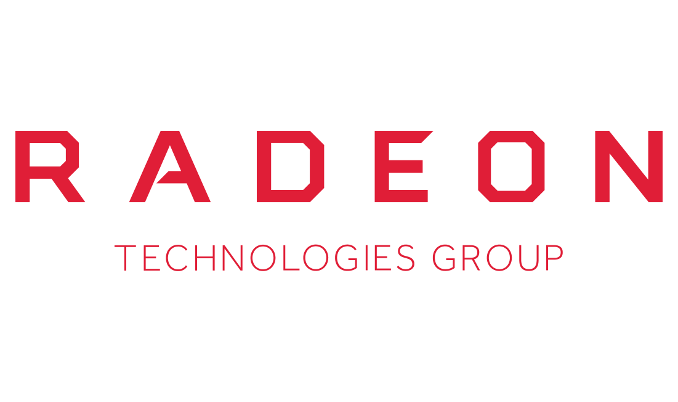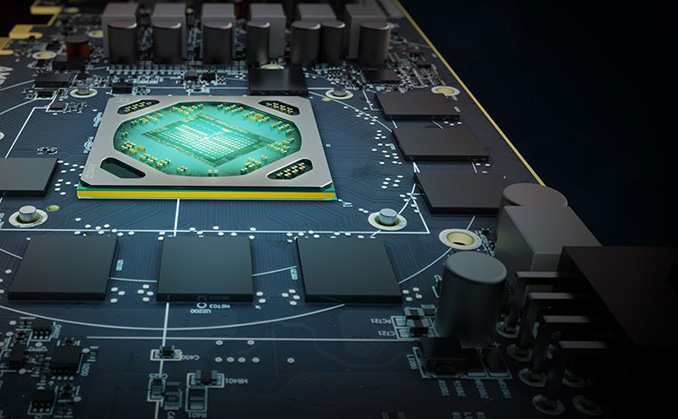AMD Releases OEM Desktop & Mobile Radeon RX 500X SKUs: The Radeon Rebadge Returns (Updated)
by Nate Oh on April 11, 2018 8:01 AM EST
Tucked inside today's HP’s announcement of their new Pavilion gaming systems is an interesting item: a mobile Radeon RX 560X graphics option. This is in fact not a typo on our part or on HP's part; rather AMD is launching a series of new and yet surprisingly familiar video card SKUs for their OEMs. That's right, we've reached that time of the year once again: the semi-annual OEM GPU rebadges have returned.
To that end, AMD today is announcing a series of new OEM-only SKUs for desktop and mobile, which we're unofficially dubbing the Radeon RX 500X series; officially, AMD is categorizing these products under the Radeon 500 series family, with two product lines: "Radeon RX 500X Series" and "Radeon 500X Series". These new SKUs are not available as retail add-in boards, instead the RX 500X series is the latest in the roughly annual GPU rebadging cycle that both GPU manufacturers participate in for PC OEMs.
As this tends happen every couple of years or so, regular readers may recall the OEM desktop Radeon 300 or HD 8000 series. But if this your first OEM rebadge cycle the summary is this: with the shorter product cycles of OEM systems versus retail channel video cards, OEMs want to advertise the latest components when they refresh and update their systems, even when new GPUs are not available. To which NVIDIA and AMD rebrand, refresh, or otherwise re-designate existing SKUs as OEM-exclusive parts.
In the case of this latest rebadge cycle, this comes on the heels of Intel's recent 8th Gen Core CPU launch, which saw AMD's rival launch a number of new CPU SKUs for desktop and mobile. And while there's a certain degree of sheer oddity to an Intel update triggering an AMD rebadge, at the end of the day OEM product cycles are primarily tied to Intel's CPU cycles. So now that OEMs have new Intel CPUs to put in their machines, they want to throw in "new" video cards to match.
As far as naming conventions go, AMD has been ambiguous thus far in whether these new SKUs are going to be treated as a wholly new series, as these are new SKUs in the existing RX 500 series. With the product pages posted after the announcement, it appears that these SKUs are falling under the same product family umbrella as the OEM Radeon 500 series. But regardless of what AMD does, as there are multiple new SKUs across the RX 500 lineup, it's convenient for us refer to them together as a single block of parts.
Adding an extra wrinkle to all of this is the fact that word of the Radeon RX 500X series got out ahead of today's announcement, so there's been a lot of people (ourselves included) wondering just what was going on. As the RX 500X series was first outed through the AMD website source code, some confusion arose about a potential retail AIB refresh, but to clarify again, the RX 500X series is an OEM-exclusive stack. Which, unfortunately doesn't mean that you won't see the new SKUs listed elsewhere; since the launch of the RX 500 series last year, AMD hasn't been maintaining a separate OEM section, so the OEM Radeon 500 series have been appearing in AMD's main graphics section.
But that's enough about the presentation. Let's get to the meat of the matter: technical specifications. While we have not seen the official specifications ahead of today's announcement, in a call with AMD we have been told that the new parts have the same nominal specifications as the old parts. That means that there have been no clockspeed adjustments or other adjustments that will cause the new OEM parts to perform differently than the existing AIB parts; it's exactly the same hardware as before.
In practice, OEMs already alter the specifications of some of their video cards by turning down clockspeeds for power efficiency reasons - especially in laptops - so expect to see the same thing here. Instead, AMD's specifications represent the highest frequencies these new parts will be clocked at, just like in past generations. Which for the AnandTech reader, means that deciphering the RX 500X specifications is very straightforward: the X doesn't change a thing.
| AMD OEM Desktop & Mobile Radeon RX 500X Series | ||||||||||||
| Radeon RX 580X |
Radeon RX 570X |
Radeon RX 560X |
Radeon RX 550X |
Radeon RX 540X |
Radeon 550X |
Radeon 540X |
||||||
| Base Model | Radeon RX 580 | Radeon RX 570 | Radeon RX 560 | Radeon RX 550 | Radeon RX 540 | Radeon RX 550 | Radeon 540 | |||||
| Stream Processors | 2304 (36 CUs) |
2048 (32 CUs) |
1024 (16 CUs) |
896 (14 CUs) |
640 (10 CUs) |
512 (8 CUs) |
512 (8 CUs) |
640 (10 CUs) |
512 (8 CUs) |
512 (8 CUs) |
||
| Texture Units | 144 | 128 | 64 | 56 | 40 | 32 | 32 | 40 | 32 | 32 | ||
| ROPs | 32 | 32 | 16 | 16 | 16 | 16 | 8 | |||||
| Boost Clock (up to) | <= 1340MHz | <= 1244MHz | <= 1275MHz |
<= 1287MHz | <= 1219MHz | <= 1287MHZ | <= 1219MHz | |||||
| Base Clock (up to) | <= 1257MHz | <= 1168MHz | <= 1175MHz | N/A | ||||||||
| Memory Clock | 8 Gbps GDDR5 | 7 Gbps GDDR5 | 7 Gbps GDDR5 | 7 Gbps GDDR5 | 6 Gbps GDDR5 | 7 Gbps GDDR5 | 6 Gbps GDDR5 | |||||
| Memory Bus Width | 256-bit | 256-bit | 128-bit | 128-bit | 128-bit | 64-bit | 64-bit | |||||
| VRAM | 8GB | 4GB/8GB | 2GB/4GB | 2GB/4GB | ||||||||
| Transistor Count | 5.7B | 5.7B | 3B | 2.2B | ||||||||
| GPU | Polaris 10 | Polaris 10 | Polaris 11 | Polaris 12 (Lexa) | ||||||||
| Process | GlobalFoundries 14nm | |||||||||||
| Architecture | GCN 4 | |||||||||||
| Listed Segment(s) | Desktop Laptop |
Desktop | Laptop | Desktop Laptop |
Laptop | |||||||
| Launch Date | 4/3/2018 | |||||||||||
As far as documentation goes, OEM GPUs (particularly mobile) have never received much attention, especially since they are subject to aforementioned OEM-specific adjustments or re-configurations. But for the most part, the RX 500X rebadging simply involves an extra ‘X’ to the name, and with the RX 560X showing up as both 14CU and 16CU variants that originally appeared last summer. And it should be noted that like the RX 500 series parts before them, AMD is maintaining a single series of SKUs for both desktop and mobile, so clockspeeds aside mobile implementations will be based on the same GPUs and have the same configurations as their desktop counterparts.
The one real wildcard in all of this is the Radeon (sans-RX) 550X, which has no directly named equivalent from the former models. So it is not clear how the four 550 & 540 class products (RX 550X, RX 540X, 550X, 540X) exactly line up. There also exists an RX 550 variant with 640 stream processors (10 compute units), quietly released earlier this year; that might be involved here, considering the RX 550 product page on the Radeon site specifies possible higher CU counts, while the product page on the main site does not specify CU count at all.
Update (4/11/18 10 a.m. ET): AMD's Radeon RX 500X and Radeon 500X product pages have finally gone live, and we have updated the table accordingly. These parts were launched just last week, with the Radeon RX 540X and Radeon 540X as 8 CU parts for laptops. Meanwhile, the Radeon RX 550X is listed for desktops and the Radeon 550X is listed for desktops and laptops, all coming in 8 CU and 10 CU variants. The non-RX 500X parts have the bus halved to 64-bit, like with the previous cycle's models, and the Radeon 540X has an additional 8 ROPs cut. But as far as the numbering goes, this stack clears up some of the confusion with previous SKUs regarding CU count, as well as the numerous Polaris 12 options. These 500X series Polaris 12 parts are listed with higher boost clockspeeds (up to 1219 or 1287MHz) than the previous RX 550 SKUs (up to 1183 MHz), but this is likely to be a documentation update rather than a clockspeed tweak.
In any case, while some may point to AMD’s announced model numbering scheme for revisions (i.e. RX 585), the RX 500X branding is to the taste of OEMs, and is not beholden to retail numbering. Instead, the purpose of the Radeon RX 500X series is - besides the obvious case of incrementing the product name - is to give OEMs a means of calling attention to all of the improvements AMD has made to the family on the driver side of matters in the last year. As non-technical customers may not be familiar with the brand and its developments such as the many new features introduced in the Radeon Software Adrenalin Edition, this is one method OEMs can use to communicate these changes to buyers without having to explain the whole concept of drivers and feature updates. Which at the end of the day won't change the fact that this is the same hardware, but it aligns with OEM logic, which as we've seen time and time again, isn't rooted in the same space as computer enthusiast logic.
Finally, other than HP’s Pavilion 15-cx0030nr laptop, the RX 560X has also been spotted ahead of today's official announcement on non-US Acer product pages for the Nitro 5 AN515-42, which was originally unveiled at CES with the RX 560 option. So along with these new laptops, we should expect to see other OEM systems incorporating the RX 500X series in the near future.
Source: AMD












44 Comments
View All Comments
Yojimbo - Wednesday, April 11, 2018 - link
When you buy a 560X you are led to think it's an enhancement of the 560, which it is not. When you buy an MX130 it has little implied relationship to the 940MX or any other GPU other than the MX110 and MX150. MX130 isn't claiming to be something it's not. It doesn't sound particularly new or shiny. There is a rebadge for freshness, but there don't seem to be any underhanded claims going on. It would be like Intel moving an old Core processor to the Pentium or Celeron lines.Personally I don't think a rebadge is too bad when it moves down the line, e.g., if a 470 goes to 560 in the next generation. But if a 470 goes to a 570 with no change, or a 470 goes to a 470X with no change it's worse.
ET - Thursday, April 12, 2018 - link
The MX130 is certainly misleading buyers. People think it's related to the MX150, which is a half decent chip, where in effect it's an old and crippled (where it comes to video processing) chip. Same with AMD on mobile with the 540 and 530, where the 530 is GCN 1.0 and has been renamed countless times.I think that's much worse because I have to deal with customers who buy these terrible chips and then have problems running software I've worked on. With a 560X, it would be fine. Sure, it might not be different than the 560, but it also has a big advantage that it's not different than a 560. :)
Yojimbo - Thursday, April 12, 2018 - link
"The MX130 is certainly misleading buyers. People think it's related to the MX150"It is related. They are both entry level laptop GPUs. The MX130 is not old. I don't see why everything named MX or MX1xx has to have the same video processing abilities. If the MX130 has been crippled in some way then that is an issue in itself and has nothing to do with the naming.
If you want to look at a case where NVIDIA is being tricky with names then look at the two GTX 1030s. In that case a consumer could easily be fooled when seeing two systems with the GT 1030, one being cheaper than the other and thinking the cheaper one is a good deal, not realizing the graphics cards are different even though they are named the same. "GT 1030 with DDR4" and "GT 1030 with GDDR5" is a bit abstruse for the average buyer of those types of machines and there are probably lots of product listings or advertisements where it isn't readily displayed that the GT 1030 in the system has DDR4 DRAM.
BurntMyBacon - Thursday, April 12, 2018 - link
@Yojimbo: "Personally I don't think a rebadge is too bad when it moves down the line, e.g., if a 470 goes to 560 in the next generation. But if a 470 goes to a 570 with no change, or a 470 goes to a 470X with no change it's worse."I fully agree with this sentiment from a performance perspective. However, there are two major issues I consider in a rebadge: Performance and Feature Set. From a performance perspective, I have no issue with a 470 moving to a 560. This even has the benefit of making comparisons between generations simple to understand. A 470 moving to a 570 with no change is downright deceptive as it implies both generational performance gains and generation feature set improvements without delivering either. A 470 moving to a 470X with no change seems like a compromise between OEM demands for something "new" and end user demands to clarify their offerings. Though, it is still deceptive in the sense that there is an implied performance gain that isn't delivered.
When moving to a new major architecture and corresponding feature set, I would like to see a clean break in product numbering as well. For instance, regardless of a Terascale part's performance, the introduction of GCN and its associated capabilities should have warranted its own unique and distinct series of SKUs as there is an implied set of features with the newer series of chips that was not delivered. However, with the lack of major changes between GCN versions (except perhaps the 5th generation), there is no need to have a clean break in series numbers. A rebadge to a newer model number in this situation is acceptable as long as the implied generational performance improvement is maintained and the new model number reflects its performance position in the new stack.
webdoctors - Wednesday, April 11, 2018 - link
I think this hurts the vendor in the longterm. I don't even consider AMD cards unless they have Vega in their name, the other cards have been rebadged for several generations from 2xx to 5xx, no idea what the comparable mainstream part would be to the 1060/1070/1080s.At least with Vega56/Vega64 you know they're legit and not rebadged stuff from 5 yrs ago.
Yojimbo - Wednesday, April 11, 2018 - link
It's not too hard to go to a site like Anandtech and look at benchmarks and figure out how the current products stack up against each other. When I want to make a purchase I do the research. I took hours deciding on equipment for grinding and brewing coffee. If someone is already aware of the 200 series through 500 series it would take 30 mins to figure out how the 580 compares with the 1060. If he needs to read about Polaris then just add 30 more minutes.Dragonstongue - Wednesday, April 11, 2018 - link
why oh why could they not do 12nm RX500X and not OEM specifically.....grrrr hard enough to find any RX 500 besides 560 or 550 that are in stock let alone even remotely close to MSRP that they should (~$287 CAD for 8gb RX580 ~ $25 less for RX570..nah they want to price the 4gb models above 8gb pricing and generally charge the same for RX 570 as they do for RX 580....not AMD fault directly, but the partners as well as idiot etrailers..most RX 560 I see are the reduce CU versions priced about $30 more then they should be as well)either way IMO they really should have done as 12nm refresh of polaris and put more on the shelf for those of us (like me) that have been waiting over a year (basically) to want to buy one and cannot or are faced with paying ~$100+ more than should be (if you are lucky enough to find ANY RX570/580 in stock, even though was claimed pricing stabilized in March..yeh fk right)
Sttm - Wednesday, April 11, 2018 - link
2016 GPUs with 2018 naming. /Fail.AMD has been so half assing their GPU division I seriously expect Intel to take their market share by 2022 when Raj Koduri's Artic Sound products launch.
kaesden - Wednesday, April 11, 2018 - link
video card releases are pointless until crypto mining somehow dies off. Pricing is ridiculous still.sing_electric - Thursday, April 12, 2018 - link
Ironically, that applies a LOT less to the OEM market where these cards will end up - OEMs are restricted with how much they can mark up machines. A few months ago before the crypto bubble started popping, I bought a complete Ryzen desktop with an RX 580 for about $50 more than the 580 was going for when you could find one in stock.